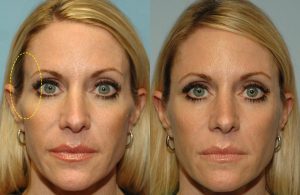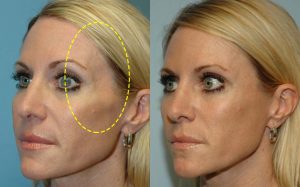Quite often patients will come to a consultation focused on a particular line, wrinkle, or fold. The assumption and hope is that by improving that particular line, wrinkle or fold a more youthful appearance will be achieved. However, there is often more to consider than just that particular concern.
There is no question that simply correcting a line, wrinkle, or fold will help one’s appearance and is certainly valuable; it nice not to see that line, wrinkle, of fold in the mirror! However, if you are looking for a more youthful, attractive, or healthier appearance then it’s best to look to the sides of the face or what I like to call the silhouette of the face, but with a particular focus on the temples.
The temples are often overlooked by patients and many offices who perform dermal filler injections. However, the temples plays a vital role in our overall facial shape and it is our facial shape, more than a few bothersome lines and wrinkles, that contributes to a youthful appearance. I often comment to patients that, in general, our facial shape should be like an upside down egg, wider on top and narrower on the bottom. With aging the egg gets flipped, we get wider or heavier on the bottom and narrower on the top, and for some patients the temples becomes very concave and the egg turns into more of a peanut. Enhancing the temples with fillers such as Juvederm, Restylane, and Belotero are excellent solutions, with longer term results seen with fat augmentation and Sculptra.
The temples can be easily and painlessly filled in a short office visit with downtime less than 1-2 days. In fact most patients feel comfortable returning to their daily routines the following day. We typically recommend avoiding aspirin and aspirin like products (e.g., Ibuprofen, Naproxen) a week before the procedure, but overall little preparation for this popular procedure is required. Some results are seen below and more in-depth information can be read within an article published by myself last year in Plastic Surgery Practice.
All procedures performed by Dr. Miller.


Timothy R. Miller, M.D.


